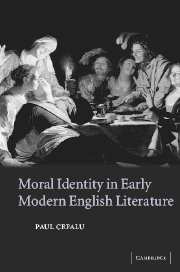Book contents
- Frontmatter
- Contents
- Acknowledgments
- Introduction: English Protestant moral theory and regeneration
- Chapter 1 Shame, guilt, and moral character in early modern English Protestant theology and Sir Philip Sidney's Countess of Pembroke's Arcadia
- Chapter 2 The three orders of nature, grace, and law in Edmund Spenser's The Faerie Queene, Book II
- Chapter 3 Conformist and puritan moral theory: from Richard Hooker's natural law theory to Richard Sibbes's ethical occasionalism
- Chapter 4 The elect body in pain: Godly fear and sanctification in John Donne's poetry and prose
- Chapter 5 Absent neighbors in George Herbert's “The Church,” or Why Agape becomes Caritas in English Protestant devotional poetry
- Chapter 6 Moral pragmatism in the theology of John Milton and his contemporaries
- Epilogue: theorizing early modern moral selfhood
- Notes
- Index
Introduction: English Protestant moral theory and regeneration
Published online by Cambridge University Press: 22 September 2009
- Frontmatter
- Contents
- Acknowledgments
- Introduction: English Protestant moral theory and regeneration
- Chapter 1 Shame, guilt, and moral character in early modern English Protestant theology and Sir Philip Sidney's Countess of Pembroke's Arcadia
- Chapter 2 The three orders of nature, grace, and law in Edmund Spenser's The Faerie Queene, Book II
- Chapter 3 Conformist and puritan moral theory: from Richard Hooker's natural law theory to Richard Sibbes's ethical occasionalism
- Chapter 4 The elect body in pain: Godly fear and sanctification in John Donne's poetry and prose
- Chapter 5 Absent neighbors in George Herbert's “The Church,” or Why Agape becomes Caritas in English Protestant devotional poetry
- Chapter 6 Moral pragmatism in the theology of John Milton and his contemporaries
- Epilogue: theorizing early modern moral selfhood
- Notes
- Index
Summary
In his 1618 sermon, Lancelot Andrewes, the Conformist Bishop of Winchester, admonishes his listeners that the fear of divine punishment can prevent apostasy: “This fear to suffer evil for sin, malum poenae, makes men fear to do the evil of sin, malum culpae; what they fear to suffer for, they fear to do.” In 1643, the English Puritan divine, William Ames, outlines for the reader a pragmatic remedy of bridling sin: “If he consider the misery of those, that obey not God, for he is the servant of sinne, to death … If he alwayes set before his eyes the threatnings against, and the vengeance which is prepared for the disobedient.” Despite their doctrinal allegiances – Andrewes is a late apologist for the Elizabethan Settlement, Ames a covenant theologian – both theologians are devoted Pauline evangelists. To invoke the prospect of damnation and a wrathful, punitive God seems like a reversion to Old Testament moralism, the legalistic tenets of which are supposedly displaced by the comforts of the Gospel. Pauline theology holds, for example, that sinners are justified by Christ's sacrifice, after which they fulfill moral law out of responsive love rather than servile fear.
Presumably Andrewes and Ames are directing their advice to penitents as well as reprobates: Andrewes's sermon is delivered before King James I; Ames's advice appears in a rather arid treatise on conscience.
- Type
- Chapter
- Information
- Moral Identity in Early Modern English Literature , pp. 1 - 16Publisher: Cambridge University PressPrint publication year: 2004

